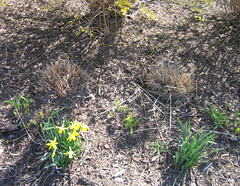The Ever Tidy Garden
When discussing spring bulbs or daylilies, I’ve noticed a recurring question: “What companion plants will camouflage post-bloom leaves?” Unless you’re prepared to replace your daffodils each fall, the fading leaves must remain until they’ve gathered the energy needed for next year’s bloom. After withering away, a bare spot is left where cheerful beacons of spring once stood. Daylily leaves, while very fresh looking in the spring, are tatty by the season’s end. Without fabulous flowers to distract the eye, the plants can look messy.
 The landscape designers at Friendship Park in Cincinnati have done an admirable job of providing season-long interest while concealing plants past their prime. This is especially true along the flag walk, at the park’s entrance. In the spring, daffodils line the walk. By summer, the daylilies planted behind the bulbs are in full glory and the ripening daffodil foliage is concealed. Finally, in the fall, the ornamental grass has grown tall enough to distract from, if not completely cover, the spent daylily foliage. (In the above picture, you can see the blooming daffodils, and behind them the emerging daylilies and then last year's grass remains.)
The landscape designers at Friendship Park in Cincinnati have done an admirable job of providing season-long interest while concealing plants past their prime. This is especially true along the flag walk, at the park’s entrance. In the spring, daffodils line the walk. By summer, the daylilies planted behind the bulbs are in full glory and the ripening daffodil foliage is concealed. Finally, in the fall, the ornamental grass has grown tall enough to distract from, if not completely cover, the spent daylily foliage. (In the above picture, you can see the blooming daffodils, and behind them the emerging daylilies and then last year's grass remains.)
The daylily/daffodil pairing has been suggested before, but adding the grass for a third season of interest is a novel idea. It isn’t exactly “cottagey,” but I’m impressed enough with the effect to consider ornamental grasses in my own beds. Or maybe I’ll just live with the ratty leaves. I wouldn’t want my garden to be too perfect.
 The landscape designers at Friendship Park in Cincinnati have done an admirable job of providing season-long interest while concealing plants past their prime. This is especially true along the flag walk, at the park’s entrance. In the spring, daffodils line the walk. By summer, the daylilies planted behind the bulbs are in full glory and the ripening daffodil foliage is concealed. Finally, in the fall, the ornamental grass has grown tall enough to distract from, if not completely cover, the spent daylily foliage. (In the above picture, you can see the blooming daffodils, and behind them the emerging daylilies and then last year's grass remains.)
The landscape designers at Friendship Park in Cincinnati have done an admirable job of providing season-long interest while concealing plants past their prime. This is especially true along the flag walk, at the park’s entrance. In the spring, daffodils line the walk. By summer, the daylilies planted behind the bulbs are in full glory and the ripening daffodil foliage is concealed. Finally, in the fall, the ornamental grass has grown tall enough to distract from, if not completely cover, the spent daylily foliage. (In the above picture, you can see the blooming daffodils, and behind them the emerging daylilies and then last year's grass remains.)The daylily/daffodil pairing has been suggested before, but adding the grass for a third season of interest is a novel idea. It isn’t exactly “cottagey,” but I’m impressed enough with the effect to consider ornamental grasses in my own beds. Or maybe I’ll just live with the ratty leaves. I wouldn’t want my garden to be too perfect.


3 Comments:
in My one bed I have daffs in the front, peonies in the middle, daylilies in the back. My goal this year is to widen the bed, plant cannas and the tall dalihas in the back,and a row of yellow mums in the front for a last shout of color before winter. This bed will be about six ft wide and 25 ft long. Grasses is a nice thought...they add visual in the winter too.
Bill from Ohio
Okay, I have a confession to make. After flowering and before they flop over, I tie up my daff foliage with little twist-ems to keep them from covering up the nice groundcover, and looking ratty, of course. Then when they're brown enough I lift 'em and toss 'em.
Yes, we've all read about 73 times we shouldn't do this but the daffs in question are going strong and even spreading after more than a decade of this treatment. But don't tell anybody I do this, okay?
This comment has been removed by a blog administrator.
Post a Comment
<< Home